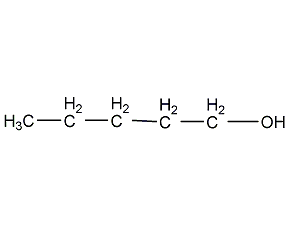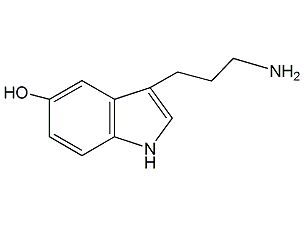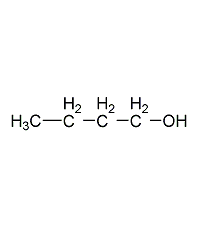
Structural formula
| Business number | 01GG |
|---|---|
| Molecular formula | C5H12O |
| Molecular weight | 88.15 |
| label |
n-pentyl alcohol, 1-pentanol, n-Amyl alcohol, Pentyl alcohol, n-Pentan-1-ol, Amyl alcohol, n-butyl carbinol, n-Pentyl alcohol, Co-solvent for nitro spray paint, paint solvents, Flotation agent for non-ferrous metals, Antifoaming agent for boiler water, alcohol solvent |
Numbering system
CAS number:71-41-0
MDL number:MFCD00002977
EINECS number:200-752-1
RTECS number:SB9800000
BRN number:1730975
PubChem number:24864733
Physical property data
1. Properties: colorless liquid with slight odor. [1]
2. Melting point (?): -78.2~79[2]
3. Boiling point (?) ): 137.5[3]
4. Relative density (water=1): 0.82[4]
5. Relative vapor density (air=1): 3.04[5]
6. Saturated vapor pressure (kPa): 0.13 (20?)[6]
7. Heat of combustion (kJ/mol): -3316.2[7]
8. Critical temperature (?): 313[ 8]
9. Critical pressure (MPa): 3.86[9]
10. Octanol/water partition coefficient: 1.40~ 1.51[10]
11. Flash point (?): 33 (CC) [11]
12. Ignition temperature (?): 300[12]
13. Explosion limit (%): 10.5[13]
14. Lower explosion limit (%): 1.2[14]
15. Solubility: slightly soluble in water, soluble in acetone, miscible in most organic matter such as ethanol and ether Solvent. [15]
16. Viscosity (mPa·s, 25ºC): 3.31
17. Heat of fusion (KJ/kg): 111.6
18. Heat of formation (KJ/mol): -360.2
19. Specific heat capacity (KJ/(kg·K), 20ºC, constant pressure): 2.98
20 .Thermal conductivity (W/(m·K), 20ºC): 16.33
21. Volume expansion coefficient (K-1, 20ºC): 0.00092
22. Critical density (g·cm-3): 0.270
23. Critical volume (cm3·mol-1 ): 326
24. Critical compression factor: 0.260
25. Eccentricity factor: 0.594
26. Solubility parameter (J·cm -3)0.5: 22.576
27. van der Waals area (cm2·mol-1 ): 8.980×109
28. van der Waals volume (cm3·mol-1): 62.630
29. Gas phase standard combustion heat (enthalpy) (kJ·mol-1): 3387.41
30. Gas phase standard claimed heat ( Enthalpy) (kJ·mol-1): -295.14
31. Gas phase standard entropy (J·mol-1·K– 1): 401.3
32. Gas phase??Quasi formation free energy (kJ·mol-1): -142.09
33. Liquid phase standard combustion heat (enthalpy) (kJ·mol-1): -3330.46
34. Liquid phase standard claims heat (enthalpy) (kJ·mol-1): -352.08
35. Liquid phase standard entropy (J·mol-1·K-1): 258.9
36. Liquid phase standard free energy of formation (kJ·mol -1): -156.61
37. Liquid phase standard hot melt (J·mol-1·K-1)?207.8
Toxicological data
1. Acute toxicity[16]
LD50: 2200mg/kg (rat oral); 3600mg/kg (rabbit dermal )
LC50: 14000mg/m3 (rat inhalation, 6h)
2. Irritation [17] sup>
Rabbit transdermal: 20mg (24h), moderate irritation.
Rabbit eye: 81mg, severe irritation.
3. Subacute and chronic toxicity [18] After multiple oral exposures to rabbits, it can cause lung, kidney and liver damage.
Ecological data
1. Ecotoxicity[19]
LC50: 370~490mg/L (96h) (fish)
EC50: 440mg/L (48h) (Daphnia)
IC50: 280mg/L (72h) (algae)
2. Biodegradability No information yet
3. Non-biodegradability No information yet
Molecular structure data
1. Molar refractive index: 26.74
2. Molar volume (cm3/mol): 108.5
3. Isotonic specific volume (90.2K ): 247.8
4. Surface tension (dyne/cm): 27.1
5. Polarizability (10-24cm3): 10.60
Compute chemical data
1. Reference value for hydrophobic parameter calculation (XlogP): None
2. Number of hydrogen bond donors: 1
3. Number of hydrogen bond acceptors: 1
4. Number of rotatable chemical bonds: 3
5. Number of tautomers: none
6. Topological molecule polar surface area 20.2
7. Number of heavy atoms: 6
8. Surface charge: 0
9. Complexity: 19.9
10. Number of isotope atoms: 0
11. Determine the number of atomic stereocenters: 0
12. Uncertain number of atomic stereocenters: 0
13. Determine the number of chemical bond stereocenters: 0
14. Number of uncertain chemical bond stereocenters: 0
15. Number of covalent bond units: 1
Properties and stability
1. Stability[20] Stable
2. Incompatible substances[21] Strong acids, strong oxidants, acid chlorides, acid anhydrides
3. Polymerization hazards[22] No polymerization
Storage method
Storage Precautions[23] Store in a cool, ventilated warehouse. Keep away from fire and heat sources. The storage temperature should not exceed 37?. Keep container tightly sealed. They should be stored separately from oxidants, acids, etc., and avoid mixed storage. Use explosion-proof lighting and ventilation facilities. It is prohibited to use mechanical equipment and tools that are prone to sparks. The storage area should be equipped with emergency release equipment and suitable containment materials.
Synthesis method
1. Photochlorination method of pentane mixture. The pentane fraction is dehydrated with anhydrous hydrogen chloride and mixed with chlorine gas at a temperature of 120-300°C. The product is cooled and distilled, and then sodium oleate is used as a catalyst, and sodium hydroxide is used. The aqueous solution hydrolyzes chloropentane, and the crude pentanol is separated from water. By distillation, pentanol containing 59% primary alcohol, 36% secondary alcohol and 5% tertiary alcohol can be obtained. According to reports, the United States mainly uses this method for production.
2. Carbonylation method of carbonyl tetraolefin. After carbonyl tetraolefin is treated with 65% sulfuric acid, carbonylation is carried out using cobalt salt as a catalyst. The water gas pressure is 14.7-19.6MPa, and the reaction temperature is 140-170°C. The carbonylation reactant is treated with hydrogen or dilute sulfuric acid to decompose the cobalt carbonyl into metallic cobalt, which is reduced under a hydrogen pressure of 17.7-19.6MPa and a temperature below 180-200°C, and then separated and refined to obtain pentanol.
In addition to water, impurities also contain a small amount of isomers such as isoamyl alcohol. During refining, dry with anhydrous potassium carbonate or anhydrous copper sulfate, filter and fractionate. It can also be treated with 1% to 2% metallic sodium and heated and refluxed for 15 hours to remove water and chloride. Trace amounts of water can be removed by heating and refluxing with a small amount of metallic sodium in the presence of 2% to 3% dipyl phthalate or dipyl succinate, and then distilling it away. To obtain high-purity amyl alcohol, it can be esterified with hydroxybenzoic acid, recrystallized with carbon disulfide, saponified with alcoholic potassium hydroxide solution, dried with calcium sulfate and fractionated. In addition, 5% to 10% benzene can also be added for azeotropic distillation to remove the water in pentanol.
3. Use industrial product n-pentanol as raw material, first dehydrate and dry with anhydrous sodium carbonate or calcium sulfate, filter and then rectify, collect the 137-139°C fraction under normal pressure to obtain the pure product.
4 Preparation methods:

In a reaction bottle equipped with a stirrer, thermometer, and reflux condenser, add 130g (1.0mol) of ethyl valerate (2) and 2000mL of absolute ethanol, and add fresh metal sodium (cut into pieces) in batches while stirring. Small pieces) 238g (10.25mol), add at a rate to keep the reaction solution refluxing vigorously. After the addition, continue to reflux for 1 hour to allow the metallic sodium to react completely. Install the fractionation device and evaporate about 700mL of ethanol. Add 800 mL of water and continue the oil bath heating fractionation until the temperature at the top of the fractionation column reaches 83°C, indicating that the ethanol has been basically evaporated and about 90% of the ethanol has been collected.??1500mL. Remove the fractionation device, perform steam distillation, collect approximately 600 mL of leachate, and 1-pentanol is basically evaporated. Separate the crude pentanol, dry it with anhydrous methanol carbonate, fractionate, and collect the fractions at 137-139°C to obtain 63g of 1-pentanol (1) with a yield of 71%. [25]
Purpose
.1. Organic synthesis. It is used as coating solvent, pharmaceutical raw material, flotation agent for non-ferrous metals, and anti-foaming agent for boiler water.
2. Mainly used to manufacture amyl acetate. Mixtures with other solvents are used as co-solvents in nitrocellulose spray paints. It is also used to extract rosin from wood and in the manufacture of spices and medicines.
3. Used in organic synthesis and drug manufacturing. [24]
extended-reading:https://www.bdmaee.net/wp-content/uploads/2022/08/Polyurethane-sealer-BA100-delayed-catalyst-BA100-polyurethane-sealing-agent.pdfextended-reading:https://www.bdmaee.net/nt-cat-dmp-30-catalyst-cas25441-67-9-newtopchem/extended-reading:https://www.bdmaee.net/dabco-ne1070-polyurethane-gel-type-catalyst-dabco-low-odor-catalyst/extended-reading:https://www.bdmaee.net/trichlorobutyltin/extended-reading:https://www.bdmaee.net/nt-cat-pc41-catalyst-cas10294-43-5-newtopchem/extended-reading:https://www.cyclohexylamine.net/33-iminobisnn-dimethylpropylamine-cas-6711-48-4-tmbpa/extended-reading:https://www.newtopchem.com/archives/44860extended-reading:https://www.bdmaee.net/wp-content/uploads/2020/06/22.jpgextended-reading:https://www.newtopchem.com/archives/40376extended-reading:https://www.newtopchem.com/archives/category/products/page/29





